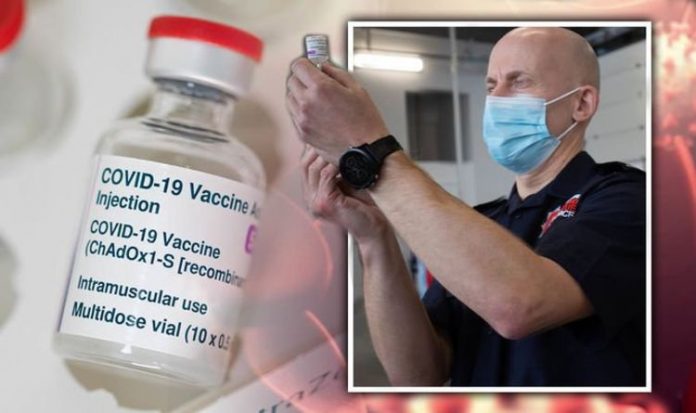More than 10.9 million people have now received the first dose of their coronavirus vaccines as the UK vaccination rollout gathers steam. The program has now reached the fourth group of the JCVI priority list, with a further 500,000 people having also received their first dose. But the latest data from NHS England has revealed the stark gap between regions – with London having inoculated four times more over 70s than Devon, for example.
The data shows the five ‘Integrated Care System (ICS) / Sustainability Transformation Partnership (STP)’ in London have vaccinate at least half of their 70 to 74-year-old population, with ‘Our Healthier South East London leading the way with 68.9 percent.
North West London Health and Care Partnership has inoculated 57.1 percent while East London Health and Care Partnership has given the first jab to 61.1 percent.
Cambridgeshire and Peterborough, along with Birmingham and Solihull, also have higher rates, with 56.8 percent given their first dose.
But these figures stand in stark contrast to much of the rest of the UK.
At the bottom of the table, Devon has vaccinated just 16 percent of 70 to 74-year-olds, with Hampshire not faring much better at 19.5 percent.
In Nottingham, 19.6 percent of those in this category have received their vaccination while those living under Shropshire and Telford and Wrekin has inoculated 18.8 percent.
Cornwall has given the jab to 23.6 percent of this age group while Sussex Health and Care Partnership has jabbed 22.7 percent.
However, the vaccination of those aged 75 to 79, and those over 80, has seen a huge take up. On average, 82.6 percent of 75 to 19s have had the jab and 88.1 percent of the over 80s.
But the figures have left some to criticise the way in which the vaccines are being rolled out.
You can see the full breakdown of areas and vaccinations in the graph below.
James Lawson, a fellow at the Adam Smith Institute think-tank, said there was a problem with the rollout being somewhat of a postcode lottery.
He said: “The best way to deal with it is a combination of better data transparency and more services to reach those harder-to-reach communities – in particular mobile vaccination centres, drive-in centres and greater use of local venues like more pharmacies and more local public venues.
“This is why it is really important to look at new ideas like launching mobile vaccination centres so that you are able to cover a greater geographical region.
“It is also why we have to look at things like drive-in centres and also greater use of pharmacies.”
Jane Townson, the chief executive of the UK Homecare Association’s (UKHCA) said there was a willingness to get the jab but the uneven rollout was hindering progress.
She said: “Even in areas where councils are doing a really good job, a proportion of providers in the local area have still not heard anything from their council. This is extremely frustrating for care workers and their employers. Based on the findings of this survey, meeting the government target could prove a challenge at the current rate of progress in some areas.”
DON’T MISS
Covid new strain symptoms: The four ‘most common coronavirus symptom’ [INSIGHT]
Britons FURIOUS as Netherlands joins EU nations snubbing UK vaccine [JUST IN]
Furious Boris holds crunch phone call with Macron over Covid vaccine [ANALYSIS]
The data does show, however, that overall London is falling behind the rest of the UK.
The capital has only vaccinated 11.5 percent of the city so far – a total of 944,822 people – based on the population from the 2011 census.
While in comparison the South West, which includes Devon, has vaccinated 15 percent of its population – though in like for like terms, this represents 923,956 people.
Elsewhere, the Midlands has vaccinated 15.1 percent of people, with the North East and Yorkshire inoculating 16.2 percent.
You can see from the graph above how the figures compare.
The release comes as Boris Johnson announced a target of vaccinating 13.9million of Britain’s most vulnerable people before mid-February.
Based on the latest seen-day rolling average of vaccination figures, 439,980 people are religion their first dose per day.
And with 10,971,047 already being vaccinated, if this rollout continues at the same pace the UK can expect to hit the Prime Minister’s target on February 12.
It is hoped the rollout will continue at this rate – and if it does, some 35,169,947 people will have been vaccinated by March 31 – more than half the country.
AstraZeneca chief executive Pascal Soriot had previously claimed 30 million people in the UK will get a dose of the vaccine “by March”.
These numbers also mean the entirety of the JCVI priority list in England will have been completed by this point, as the first 9 groups amounts to some 30,194,470 people according to the latest census data.







